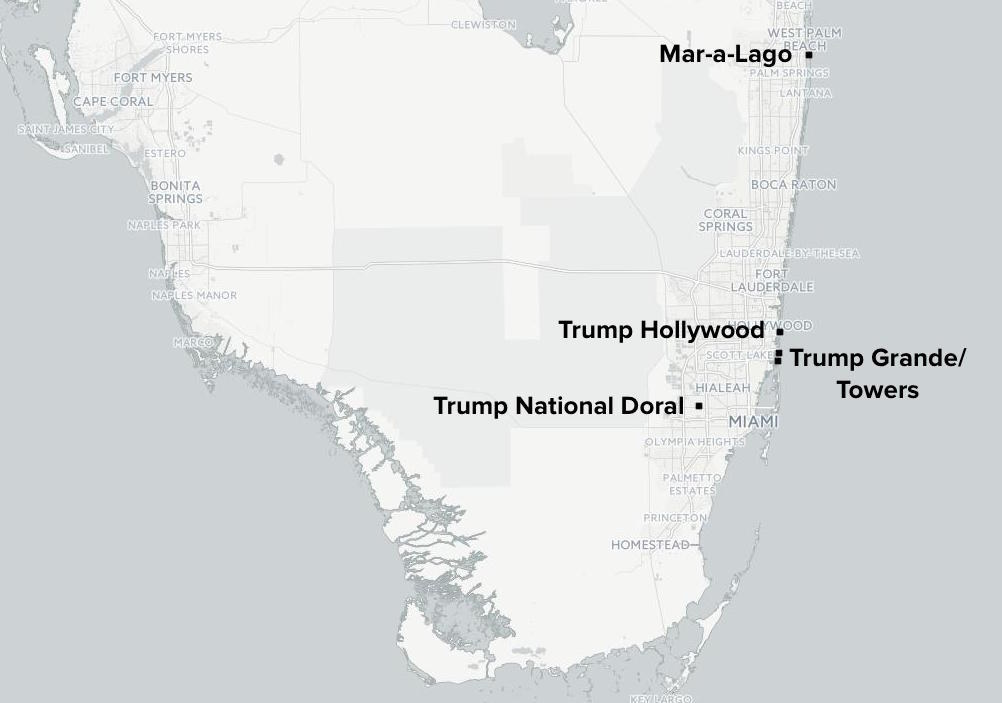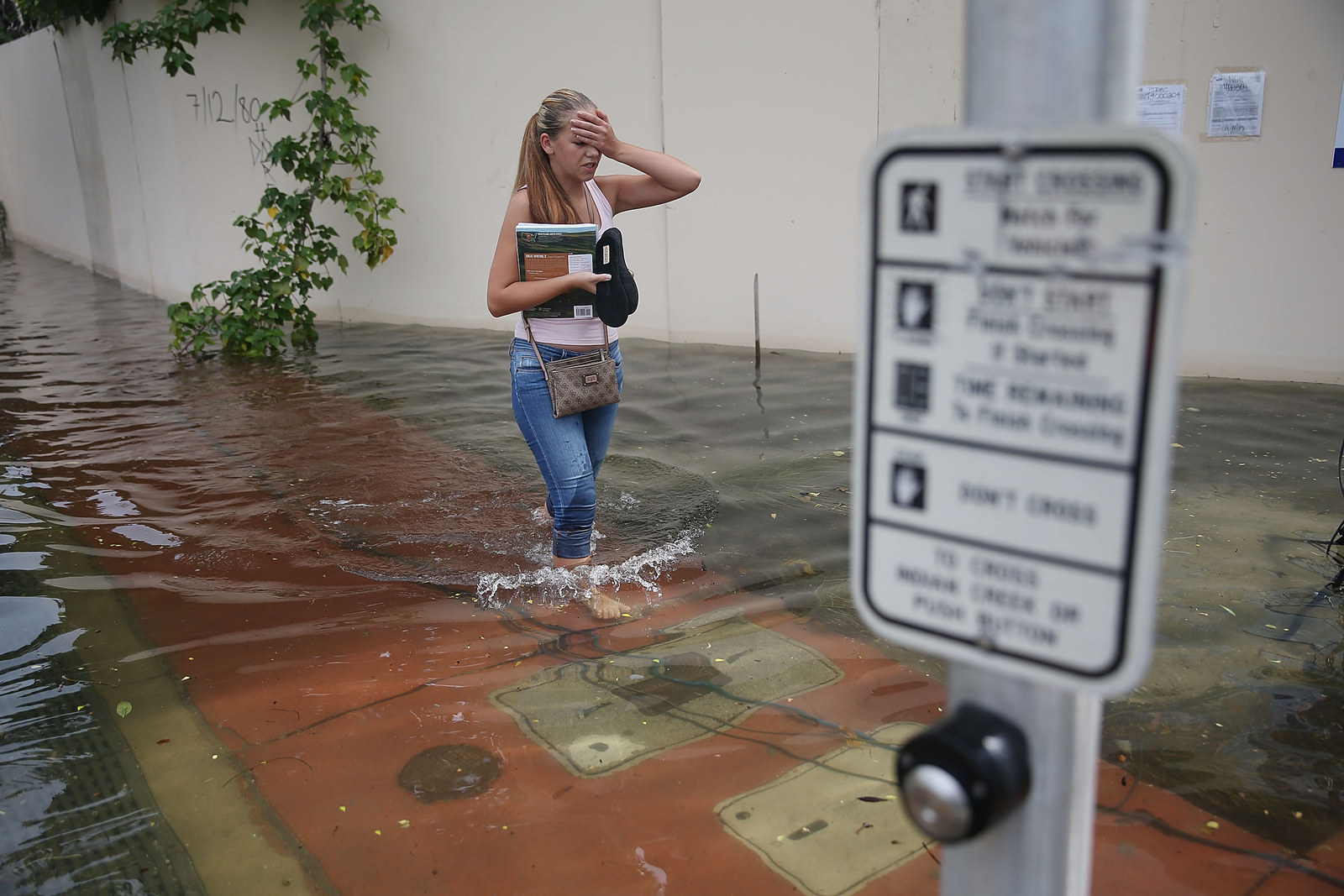Hollywood, Florida
“Located on 240 feet of pristine beach, Trump Hollywood offers spectacular views of the ocean,” boasts the Trump Organization on its website. Three-bedroom units in this 41-story luxury development are currently on sale for around $3 million apiece.
But by the end of this century, the ocean could be way too close for comfort. According to data from the National Oceanic and Atmospheric Administration (NOAA), three feet of sea level rise could turn the building into an island at the highest tides. Six feet would submerge most of the surrounding neighborhood.
But Donald Trump doesn’t buy any of that. Global warming, he has said, is “a total hoax” and “bullshit.”
The concept of global warming was created by and for the Chinese in order to make U.S. manufacturing non-competitive.
We should be focused on clean and beautiful air-not expensive and business closing GLOBAL WARMING-a total hoax!
Give me clean, beautiful and healthy air - not the same old climate change (global warming) bullshit! I am tired of hearing this nonsense.
With Trump’s rejection of climate change becoming a campaign issue, BuzzFeed News has mapped the properties listed in his US portfolio, superimposing the high tides projected by NOAA under varying amounts of sea level rise.
Three to six feet of sea level rise may sound like a lot. But it’s within the range that local authorities in Florida are planning for over the coming decades. The Southeast Florida Regional Climate Change Compact, which represents the four counties in the region, last October estimated that by 2100, the sea would rise by between 28 and 58 inches above today’s average.
Our maps reveal a watery future. Here, for example, are the locations of two more Trump-branded properties at Sunny Isles Beach, about five miles south of Trump Hollywood.
Sunny Isles Beach, Florida
Although these buildings may remain just above sea level, access will likely be a problem by the end of the century as much of the surrounding area disappears beneath the waves.
“Even though a certain property might be sort of dry, there’s going to be absolutely no way of getting to it,” Billy Brooks, a geospatial analyst at NOAA’s Office for Coastal Management in Charleston, South Carolina, told BuzzFeed News.
The properties at Hollywood and Sunny Isles Beach are not owned by Trump; he merely licenses his name to be used by the owners. But elsewhere in Florida, he has some major investments of his own.
They include the Mar-a-Lago, a private club and spa in Palm Beach, about an hour’s drive north of Hollywood, valued at $40 million by the Bloomberg Billionaires Index.
Palm Beach, Florida
He also owns Trump National Doral, a luxury golf resort in the Miami suburbs, valued by Bloomberg at $130 million. Even though it lies more than 10 miles from the current coastline, 6 feet of sea level rise could turn golf at Doral into an amphibious activity.
Doral, Florida
NOAA’s maps of ground height are very accurate, but the timing of inundation is more uncertain. The Southeast Florida Regional Climate Change Compact is anticipating 3 feet or more of sea level rise by the end of the century, but it could come sooner than that. Alternatively, if the world’s nations manage to significantly cut their greenhouse gas emissions, the rise could be slower.
Neither the Trump Organization nor his presidential campaign responded to requests for comment on the impact of sea level rise on his property portfolio. But given widespread skepticism about climate change among Republican primary voters, Trump has political reasons to reject the scientific consensus on climate.
Last month, conservative radio host Hugh Hewitt asked him directly: “Do you believe that sea levels are increasing dramatically, Donald Trump?”
“No, no I don’t,” Trump replied.
South Florida Coast

Trump is far from alone among developers in ignoring the threat posed by rising seas. The South Florida coast is in the midst of a real estate boom, as developers scramble for rich profits, anticipating returns on their investment on timescales much shorter than the decades-long horizon shown on our maps.
“As a consultant, if a client came to me and asked about the prospects of developing oceanfront property, I would certainly think it would be appropriate to advise my client to consider the risks,” Larry Hirsh, president of Golf Property Analysts in Conshohocken, Pennsylvania, told BuzzFeed News by email. “However, given that oceanfront property is scarce and in demand, I’m not sure the impact of sea level rise will be considered significant until something dramatic occurs.”
Dramatic events are always possible along a coastline threatened each summer by hurricanes. In August 1992, Hurricane Andrew caused the sea to surge up to 17 feet above its normal level near Florida’s southern tip. Rising seas will only increase the likelihood of catastrophic flooding if a major hurricane pounds the coast.
Even if developers aren’t yet worried about sea level rise, it’s on the radar of the architects they commission to design their projects.
“We think about making permanent additions to the city,” Allan Shulman, principal of Shulman and Associates in Miami, and a lecturer in architecture at the University of Miami, told BuzzFeed News. For Shulman, that means designing buildings that can withstand having their ground floors and basements flooded without suffering major structural damage.

City managers are also thinking about how to keep their communities alive as the Atlantic Ocean rises. Simply building barriers to hold back the sea isn’t an option: The region sits on permeable limestone, and water already rises up through the ground to flood low-lying streets at the highest tides.
Leading the way is the city of Miami Beach, which is two years into a $500 million project to raise roads by a couple of feet and install pumps to remove water from low-lying areas during storms and high tides.
“The conversation is not about retreat. The conversation is about adapting,” Susanne Torriente, chief resiliency officer for Miami Beach, told BuzzFeed News.
Still, scientists estimating sea level rise in the coming decades warn that the costs of defending vulnerable coastlines will eventually become prohibitive. And South Florida isn’t the only region affected. Here is another Trump-licensed property, a luxury hotel at Waikiki Beach on the island of Oahu in Hawaii.
Waikiki Beach, Oahu, Hawaii
Already, water can be seen splashing up from the storm drains near the Trump Tower when the tide is high and the waves are strong, Chip Fletcher, a coastal geologist at the University of Hawaii at Manoa, told BuzzFeed News.
By the end of the century, Fletcher said, he isn’t optimistic about the luxury developments that today crowd Waikiki Beach. “They’re just going to end up as slums — as destroyed infrastructure in the surf zone.”
